€75k per hour – Filippo Ganna's full gear and kit list for his Hour Record attempt
Clincher tyres, road shoes, 64t chainring among the finer details of Italian's set-up for Saturday
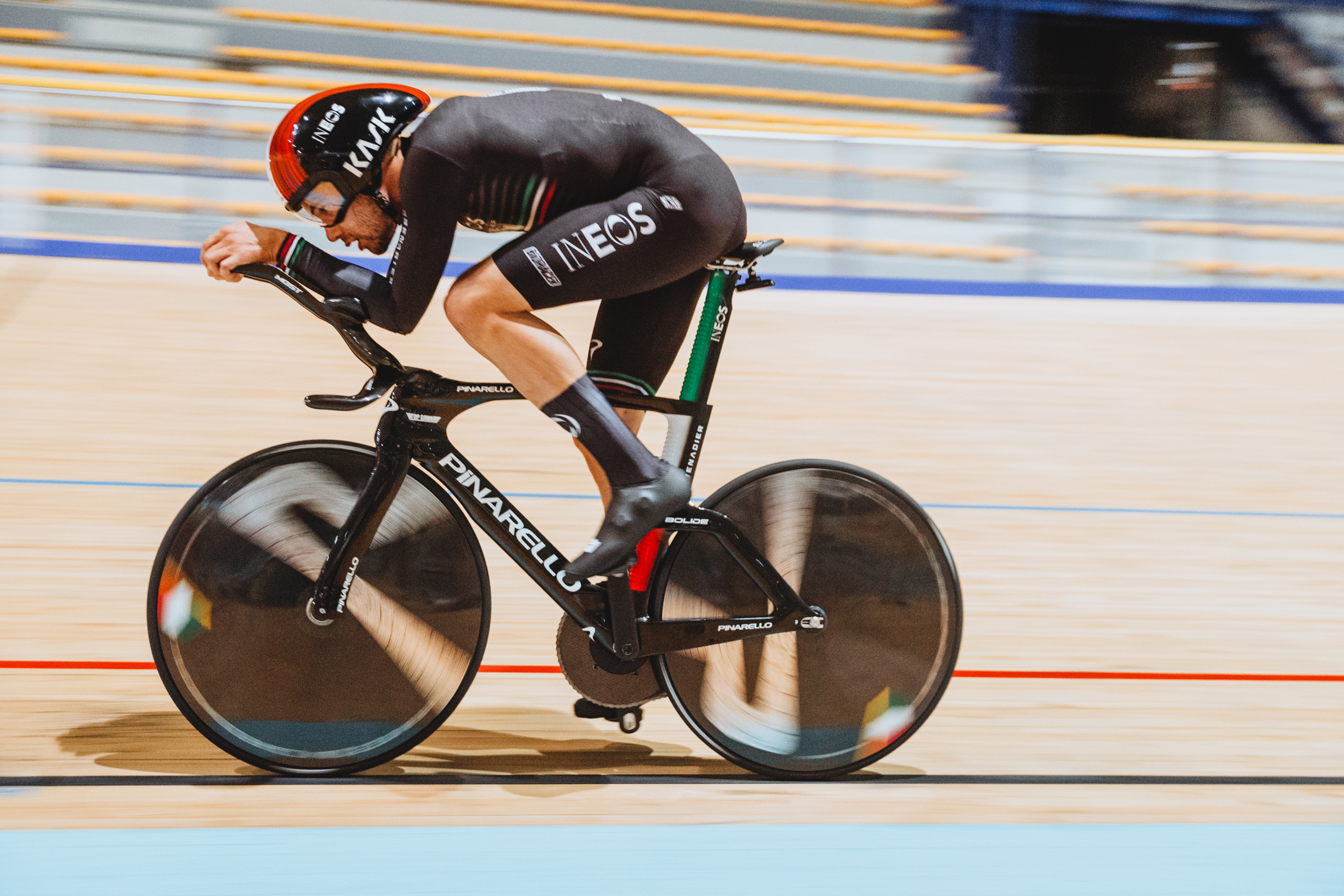
On Saturday, October 8, Filippo Ganna smashed right through the existing Hour record, and even those on previously banned bikes, to ride to an astounding 56.792km in Grenchen, Switzerland, 450m above sea level. He's put over a kilometre into the 55.548km record set by Dan Bigham just weeks ago.
Cyclingnews had gathered all the details of the Italian's equipment and kit, and we take a deep dive into the aero optimisations, which add up to an eye-watering sum of money and eye-watering levels of watts and metres.
Bigham is a British aerodynamics expert with a history of finding aero optimisations, some of which straddle the UCI rules. He is an accomplished time triallist in his own right, but he is also the Performance Engineer at Ganna's team, Ineos Grenadiers.
As the two worked towards Ganna's tilt at the record, his own record-breaking ride could be seen as something of an hors d'oeuvre to Ganna's main course. In a way, he has been the mastermind of the plot to break his own record.
The pair have worked tirelessly on what has been previously dubbed Project 0.15, referring to the desire to bring Ganna's CdA to the incredibly low number of 0.15.
CdA stands for Coefficient of Drag x Area. It is quantified in metres squared. The drag coefficient is effectively a definition of how easily air passes over an item's surface. This is primarily affected by the shape of the item, but it can also be affected by surface material. The area is the item's frontal area, or size.
It's not confirmed whether the pair were successful with that particular target, but it's fair to say that Ganna was among the most aerodynamically optimised time triallists in the world.
Get The Leadout Newsletter
The latest race content, interviews, features, reviews and expert buying guides, direct to your inbox!
Last week, Bigham told Cyclingnews that Ganna's setup would be almost exactly the same as his own, save for a few small changes.
"The only things different are the saddle and the pedals, and obviously all the contact points," he explained. "The actual frame, wheels, tyres, crank, chain, chainring, cog are all the same. Actually, the main thing we have improved is the drivetrain. Muc-Off has developed a new coating for the rear cog, which adds around 20-25 metres. It all adds up. Beyond that, it's basically the same bike."
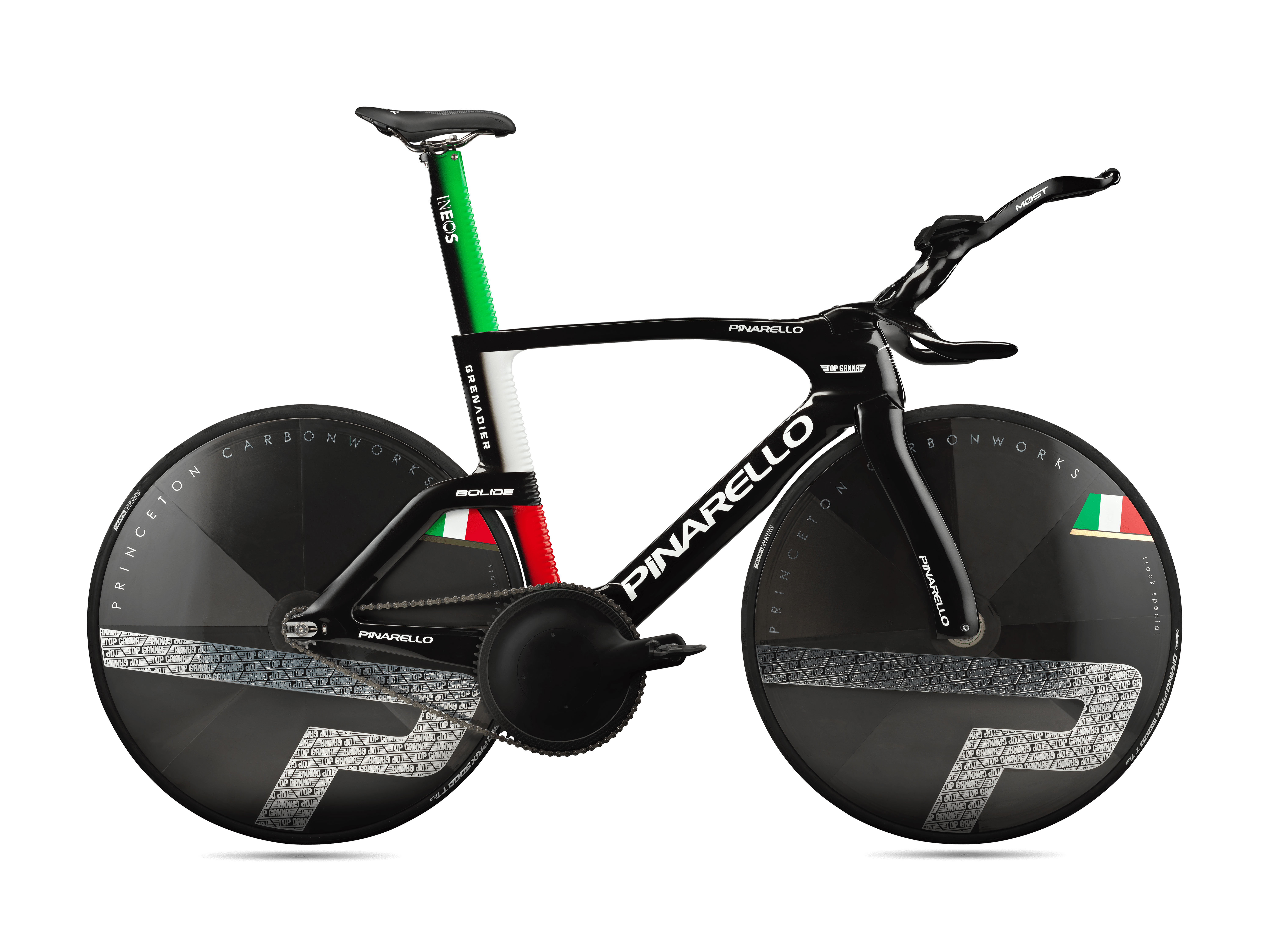
The bike, cockpit, groupset and wheels
That 'same bike' was unveiled officially on Monday last week by Pinarello as the Bolide F HR 3D. It is 3D Printed from a high-strength scandium-aluminium-magnesium alloy, made to measure for the Italian.
It was made in collaboration with 3D-printing company Metron Advanced Equipment, conveniently based in Derby, the same city in which Bigham enjoyed early success at the Derby Arena velodrome. It became the first 3D-printed aerodynamic bike to be UCI-compliant and is reportedly worth €33,000.
The bike is also fitted with a custom-made 3D-printed cockpit, this time from Pinarello's component subsidiary, MOST, at a confirmed cost of between €17,000 and €20,000 depending on each potential customer's individual initial assessment.
Elsewhere, the wheels are special edition track wheels from long-time Ineos Grenadiers supplier Princeton Carbonworks. These were designed from scratch, specifically to go with the new frame, and are reportedly priced at €8,000 a pair. The rear wheel is asymmetric, with larger-than-usual bearings.
One interesting revelation is the decision to use clincher wheels and tyres, rather than the more established option of tubulars. When Victor Campanaerts set the record in 2019, he used Vittoria Pista tubular tyres in an unfathomably-narrow-by-today's-standards 19mm.
Ganna, by comparison, used Continental's GP5000 TT tyres - the recently released TDF edition - in 25mm, with what we believe to be latex inner tubes inside.
Tyre pressures are unconfirmed, but after Bigham's attempt, he gave a clue, suggesting it was higher than most would expect. This is likely due to the smooth surface of the velodrome not benefitting as much from the bump-absorbing properties of lower pressures.
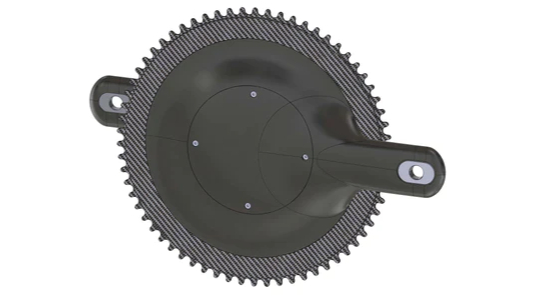
Ganna was running 170mm Wattshop Cratus aero cranks – Wattshop being Bigham's own aero componentry company – with a 64-tooth chainring. This was be paired with a 14-tooth rear cog from the same Wattshop Cratus range.
Connecting the two was an Izumi KAI chain, for a total drivetrain cost of around £1,100.00 (€1,250). The entire drivetrain will receive a special low-friction coating from British brand Muc-Off.
With this gear, Ganna needed to average a cadence of at least 96 RPM to break the record. In fact, a perfect cadence of 96RPM would have netted Ganna a distance of 55.570km. However, that was assuming he rides perfectly on the black line for the entire hour. Hitting his mark of 56.792km, Ganna would have had to average over 98RPM.
Bigham indicated that Ganna would follow suit in looking to ride a negative split, going conservatively - and at lower cadence - in the first half before lifting the pace in the back end.
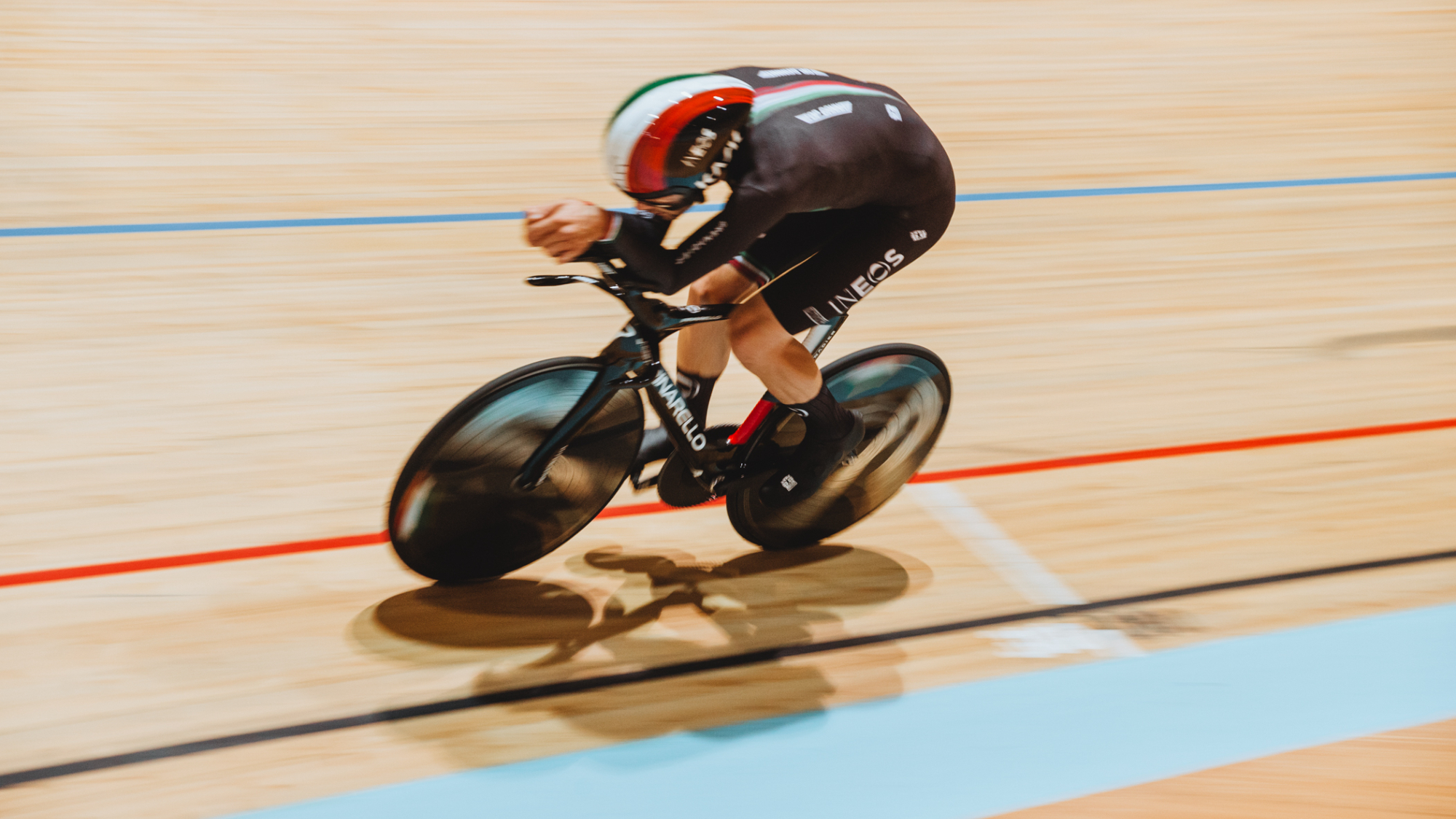
Riding on the black line is seen as the shortest route around the track. Riding on the outside - the right hand side - of that line would mean Ganna travels a greater distance to complete each lap.
The red line, which is the next line over at approximately a metre away, is 5.7m longer on the Tissot Velodrome.
The distance is not calculated based on the distance covered by Ganna's tyres, but rather the number of laps completed multiplied by the official lap distance for the Tissot Velodrome, 250m.
Put simply, if Ganna strayed away from the black line, he would have wasting metres.
The finishing specs
The bike was fitted with CeramicSpeed bottom bracket bearings. When we spoke to Alex Dowsett ahead of his last Hour Record attempt, he confirmed that all bearings would be run without the seals fitted, saying this is terrible for dirt ingress but marginally faster over the course of a one-hour indoor ride.
There's no confirmation as to whether Ganna's bike received the same treatment, but it's likely to be the case.
Ganna's usual saddle of choice for time trials is the Fizik Ares, so we believe that same theme will continue here.
Bigham is a keen advocate of Speedplay pedals for the marginal aero gain offered by the smooth cleats and their lower stack height, but Ganna has a history of using Shimano Dura-Ace pedals, and recon rides suggest that's what he'll use.
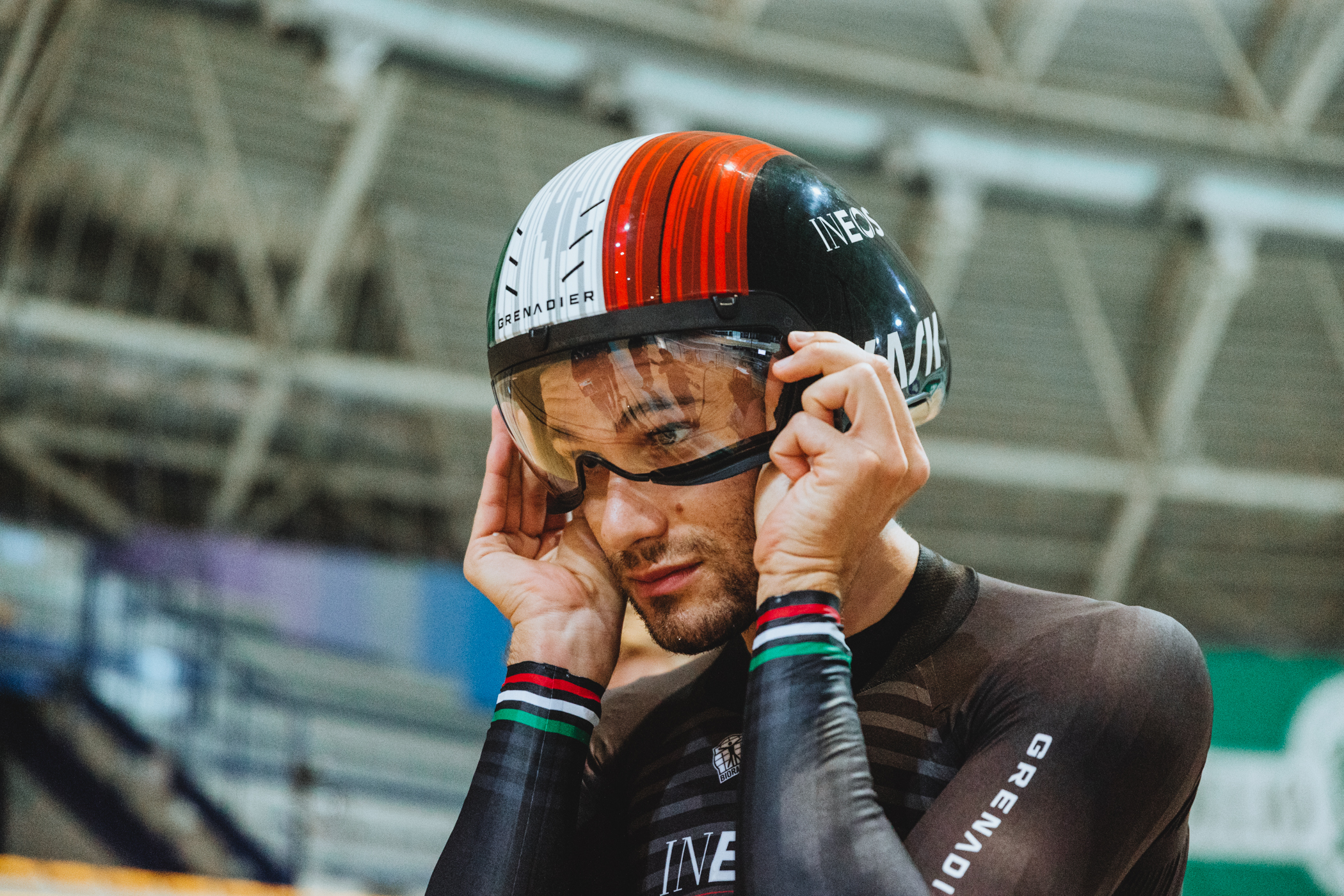
Clothing, shoes and helmet
Onto Ganna himself, and Bigham's earlier confirmation and images from recon rides suggest that the Italian will use the same model of skinsuit, the Bioracer Katana, along with Bioracer aero overshoes; both custom-made pieces borne from over 300 hours in the wind tunnel. Pricing information is unavailable, but judging by the £7,000 (€8,000) charged by competitor Vorteq for a similar service, we believe Ganna's clothing was priced at around that mark, once wind tunnel time is factored into account.
He also used the Kask Bambino Pro Evo helmet, on which it appears he's using the Aero Pro visor with an aero trip spoiler that first showed up during the opening time trial of the Tour de France.
Notably, unlike Dowsett and (we believe) Bigham before him, Ganna looks to have used his standard Northwave Extreme road shoes, rather than a custom carbon fibre shoe that places the protruding Boa dials away from the front, increasing the smoothness required for a lower CdA. The Northwave shoes have a pair of Boa dials on the outstep, although these have been smoothed out a little by the Bioracer overshoes.
Finally, we also received confirmation that Ganna used a Core-branded temperature sensor, which fits onto his heart rate strap and monitors his skin and core body temperature throughout the effort.
It's unlikely this information would have been available in real-time to Ganna, as the UCI rules forbid him from viewing a cycling computer during the effort, but it will be recorded for post-race analysis and might be visible to coaches at the trackside.
Totalled up, the main pieces of Ganna's setup, including the frame, cockpit, wheels, skinsuit and drivetrain, add up to around €70,000. Once you factor in the additional parts, such as bearings, drivetrain treatment, tyres, shoes, helmet and more, we wouldn't be surprised to see Ganna's kit list coming in at over €75,000. And that's before you get onto the hire of the Velodrome, the travel costs and the thousands of hours spent on research in advance.

Josh is Associate Editor of Cyclingnews – leading our content on the best bikes, kit and the latest breaking tech stories from the pro peloton. He has been with us since the summer of 2019 and throughout that time he's covered everything from buyer's guides and deals to the latest tech news and reviews.
On the bike, Josh has been riding and racing for over 15 years. He started out racing cross country in his teens back when 26-inch wheels and triple chainsets were still mainstream, but he found favour in road racing in his early 20s, racing at a local and national level for Somerset-based Team Tor 2000. These days he rides indoors for convenience and fitness, and outdoors for fun on road, gravel, 'cross and cross-country bikes, the latter usually with his two dogs in tow.